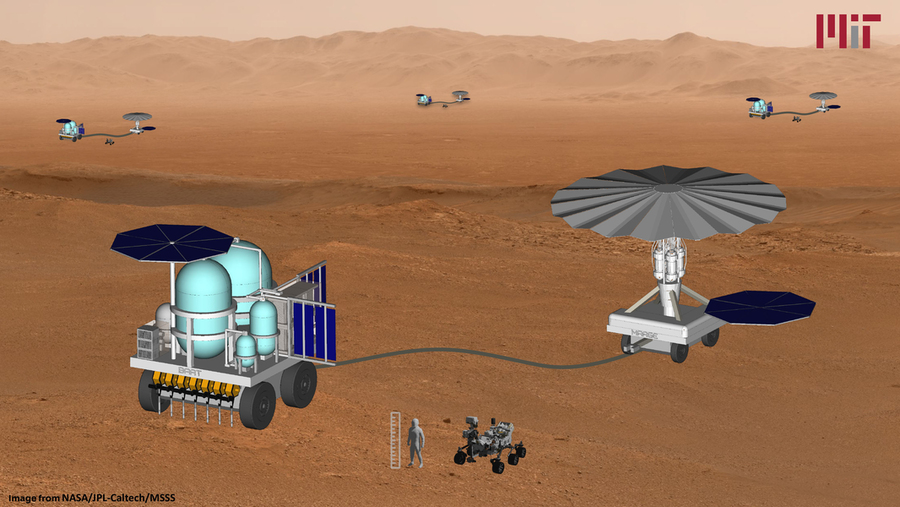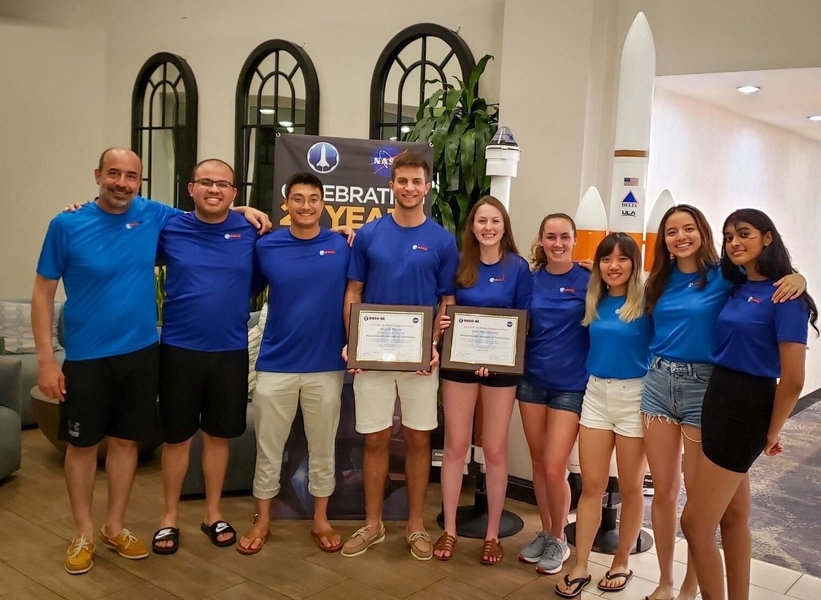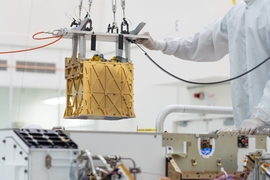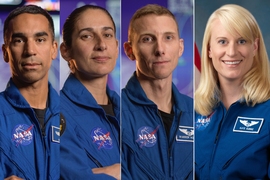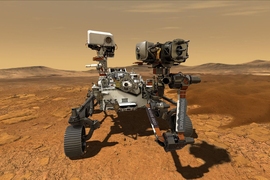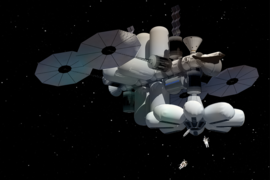Using the latest technologies currently available, it takes over 25,000 tons of rocket hardware and propellant to land 50 tons of anything on the planet Mars. So, for NASA’s first crewed mission to Mars, it will be critical to learn how to harvest the red planet’s local resources in order to “live off the land” sustainably.
On June 24, NASA announced that an MIT team received first place in the annual Revolutionary Aerospace Systems Concepts – Academic Linkage (RASC-AL) competition for their in-situ resource utilization (ISRU) design that produces propellant on Mars from local resources instead of bringing it from Earth.
Their project “Bipropellant All-in-one In-situ Resource Utilization Truck and Mobile Autonomous Reactor Generating Electricity” (BART & MARGE) describes a system where pairs of BART and MARGE travel around Mars in tandem; BART handles all aspects of production, storage, and distribution of propellant, while MARGE provides power for the operation. After presenting their concept to a panel of NASA experts and aerospace industry leaders at the RASC-AL Forum in June, the team took first place overall at the competition and was also recognized as “Best in Theme.”
“Previous ISRU concepts utilized several different small rovers and a fixed central plant, but MIT’s BART and MARGE concept is composed of essentially just two types of fully mobile, integrated large trucks with no central plant,” says Chloé Gentgen, PhD candidate in the Department of Aeronautics and Astronautics (AeroAstro) who served as team lead for the project. “The absence of a central plant enables easy scalability of the architecture, and being fully mobile and integrated, our system has the flexibility to produce propellant wherever the best ice reserves can be found and then deliver it wherever it is needed.”
Gentgen led an interdisciplinary group of undergraduate and graduate students from MIT, including Guillem Casadesus Vila, a visiting undergraduate student in AeroAstro from the Centre de Formació Interdisciplinària Superior at the Universitat Politècnica de Catalunya; Madelyn Hoying, a PhD candidate in the Medical Engineering and Medical Physics program within the Harvard-MIT Program in Health Sciences and Technology; AeroAstro alum Jayaprakash Kambhampaty ’22, rising MIT senior Mindy Long of the Department of Electrical Engineering and Computer Science (EECS); rising sophomore Laasya Nagareddy of the Department of Mathematics; rising junior John Posada of AeroAstro; and rising sophomore Marina Ten Have of EECS. The team was formed last September when interested students joined the project. AeroAstro PhD candidate George Lordos, who founded the MIT Space Resources Workshop and who has led or advised all MIT NASA competition teams since 2017, was a mentor for the project team. Jeffrey Hoffman, professor of the practice in AeroAstro; and Olivier de Weck, Apollo Program Professor and professor of astronautics and engineering systems in AeroAstro, served as faculty advisors.
“One year ago, the MOXIE experiment led by Dr. Michael Hecht and our team’s advisor, Professor Jeffrey Hoffman, produced the first oxygen on Mars. Today, we are on the cusp of orbital test flights that will bring us closer to the first human mission to Mars,” says Lordos. “As humans venture to other worlds, finding and utilizing local water and carbon resources will be indispensable for sustainable exploration of the solar system, so the objective of our MIT team’s concept is an exciting and topical technology.”
The MIT team addressed the RASC-AL theme “Mars Water-based ISRU Architecture,” which required delivering the target 50 tons of propellant at the end of each year and the ability to operate for at least five years without human maintenance. A few other constraints were placed, chief among them that teams could rely on one or more landings of 45 tons of mass and 300 cubic meters of volume on Mars, leaving it to university teams to propose an architecture, budget, and a flight schedule to support their mission.
They developed a comprehensive Mars mission architecture and defined a comprehensive concept of operations, from a precursor ice scouting and technology demonstration mission in 2031 to the main propellant production, storage, and delivery mission in 2036. BART is an end-to-end “ice-to-propellant” system that gathers water from Martian subsurface ice and extracts carbon dioxide from the red planet’s atmosphere to synthesize liquid methane and liquid oxygen bipropellant. These are then stored onboard at cryogenic temperatures until delivery directly into a rocket’s propellant tanks.
BART is accompanied by MARGE, a 40 kilowatt electric mobile nuclear reactor based on NASA’s Kilopower Reactor Using Stirling Technology project (KRUSTY, which also inspired the MIT team’s name) that generates power from nuclear fission to support long-duration operations on distant planets. For the team’s proposed mission, four tandems of BART and MARGEs will roam the region known as Arcadia Planitia at the mid-northern latitudes of Mars following a prospecting rover named LISA (Locating Ice Scouting Assistant) in search of accessible ice to use for propellant production. The entire system has 100 tons of storage capacity and can produce 156 tons per year, against a demand of 50 tons per year, and requires only three landings.
“When designing our concept, we focused on reliability and operational flexibility as our system-level design principles, to guarantee that the architecture could provide the propellant needed for a Mars ascent vehicle to be refilled before the first humans arrive on Mars, and that even after multiple years of robotic-only operations. Ultimately, our design achieved double-fault tolerance,” explains Casadesus Vila, who served as architecture lead on the project. “Next, we plan to present the BART & MARGE concept at an aerospace conference to get feedback from the ISRU community, and we will then describe the analysis work we have done in more detail for publication in a peer-reviewed journal,” adds Gentgen.
More than 50 teams responded to the initial call for RASC-AL entries, where participants submitted a proposal and a two-minute video. While this year marks the first time an MIT team took the top spot overall, MIT is no stranger to the RASC-AL competition. Previously, MIT placed first in the graduate division in 2017 and 2010 and second overall in 2016. In addition, MIT teams supported by Space Resources Workshop have won awards at other NASA competitions, including First Place Overall and Most Water Collected at the 2021 RASC-AL Special Edition for the HYDRATION III Mars Ice drilling system, and the Path to Flight and Industry Collaboration Awards for the MELLTT lunar tower system at the 2020 BIG Idea Challenge. Both Gentgen and Lordos spearheaded a sustained effort to increase MIT student participation in NASA-sponsored projects and competitions. This year, they were recognized for their leadership with the Apollo Program Prize given by MIT AeroAstro during their annual recognition ceremony in the spring.
“George Lordos and Chloé Gentgen brought together MIT students from all academic levels and four different departments. They mentored and led them throughout the past year and demonstrated how MIT AeroAstro is a great program providing system integration,” says de Weck. “The team framed their search for a superior ISRU architecture by stating that the question wasn’t how to produce propellant on Mars, but rather how to do so reliably and in a scalable way. Their application of state-of-the-art systems engineering yielded this award-winning, novel, and robust Mars propellant production architecture. We hope to see MIT’s BART & MARGE at Arcadia Planitia on Mars in the not-too-distant future.”
